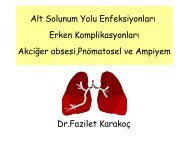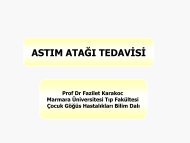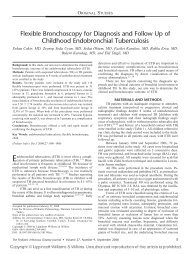Report of the UK Cystic Fibrosis Trust Antibiotic Working Group
Report of the UK Cystic Fibrosis Trust Antibiotic Working Group
Report of the UK Cystic Fibrosis Trust Antibiotic Working Group
Create successful ePaper yourself
Turn your PDF publications into a flip-book with our unique Google optimized e-Paper software.
7.9.6 Recommendations for invasive pulmonary aspergillosis, aspergillomas, andaspergillus bronchitis.• The optimum <strong>the</strong>rapy for non-ABPA presentations <strong>of</strong> Aspergillus sp. in persons with CF remainsuncertain. The options for systemic antifungal <strong>the</strong>rapy include amphotericin B (non-lipid orlipid preparations), voriconazole or casp<strong>of</strong>ungin. In some presentations e.g., TBA, surgicaldebidement may also be <strong>of</strong> benefit [C].7.9.7 O<strong>the</strong>r fungiO<strong>the</strong>r fungi are an increasingly recognised complication <strong>of</strong> CF. Scedosporium apiospermum isfrequently isolated from persons with CF and has been associated with a symptom complex similar toABPA. 174 Unlike Aspergillus sp. it has been difficult to isolate from <strong>the</strong> environment. Patients canbecome chronically colonised with <strong>the</strong> same strain 175 [3] which can persist in spite <strong>of</strong> antifungal<strong>the</strong>rapy. It is also capable <strong>of</strong> causing invasive disease with high mortality post lung-transplant. 176 [3]Therapy is compromised by its resistance to many antifungal agents, including itraconazole andamphotericin B. 177 [3] Many isolates appear susceptible in vitro to voriconazole 178;179 [3] but this hasbeen associated with clinical failure in patients 180 and in animal models. 181 [3] In vitro data suggeststhat posaconazole may also be a possible treatment. 182 [3] Ano<strong>the</strong>r fungus increasingly observed isExophiala dermatitidis. However, its significance in CF remains uncertain. 1837.9.8 Recommendations for unusual fungal infection• If considered clinically significant, Scedosporium apiospermum should be treated withvoriconazole or posaconazole [C].7.10 References1. Govan JR, Hughes JE, Vandamme P. Burkholderia cepacia: medical, taxonomic and ecological issues. J Med Micro1996;45:395–407.2. LiPuma JJ. Burkholderia cepacia. Management issues and new insights. Clin Chest Med 1998;19:473–86.3. Jones AM, Dodd ME, Webb AK. Burkholderia cepacia: current clinical issues, environmental controversies andethical dilemmas. Eur Respir J 2001;17:295–301.4. Coenye T, Vandamme P, Govan JR, LiPuma JJ. Taxonomy and identification <strong>of</strong> <strong>the</strong> Burkholderia cepacia complex.J Clin Microbiol 2001;39:3427–36.5. Whiteford ML, Wilkinson JD, McColl JH, Conlon FM, Michie JR, Evans TJ et al. Outcome <strong>of</strong> Burkholderia(Pseudomonas) cepacia colonisation in children with cystic fibrosis following a hospital outbreak. Thorax1995;50:1194–8.6. Muhdi K, Edenborough FP, Gumery L, O’Hickey S, Smith EG, Smith DL et al. Outcome for patients colonisedwith Burkholderia cepacia in a Birmingham adult cystic fibrosis clinic and <strong>the</strong> end <strong>of</strong> an epidemic. Thorax1996;51:374–7.7. Hutchison ML,.Govan JR. Pathogenicity <strong>of</strong> microbes associated with cystic fibrosis. Microbes & Infection1999;1:1005–14.8. McCloskey M, McCaughan J, Redmond AO, Elborn JS. Clinical outcome after acquisition <strong>of</strong> Burkholderia cepaciain patients with cystic fibrosis. Ir J Med Sci 2001;170:28–31.9. Mahenthiralingam E, Vandamme P, Campbell ME, Henry DA, Gravelle AM, Wong LT et al. Infection withBurkholderia cepacia complex genomovars in patients with cystic fibrosis: virulent transmissible strains <strong>of</strong>genomovar III can replace Burkholderia multivorans. Clin Infect Dis 2001;33:1469–75.10. Jones AM, Dodd ME, Govan JR, Barcus V, Doherty CJ, Morris J et al. Burkholderia cenocepacia and Burkholderiamultivorans: influence on survival in cystic fibrosis. Thorax 2004;59:948–51.11. Manno G, Dalmastri C, Tabacchioni S, Vandamme P, Lorini R, Minicucci L et al. Epidemiology and clinicalcourse <strong>of</strong> Burkholderia cepacia complex infections, particularly those caused by different Burkholderia cenocepaciastrains, among patients attending an Italian <strong>Cystic</strong> <strong>Fibrosis</strong> Center. J Clin Microbiol 2004;42:1491–7.<strong>Cystic</strong> <strong>Fibrosis</strong> <strong>Trust</strong> 7.9.6March 2009






